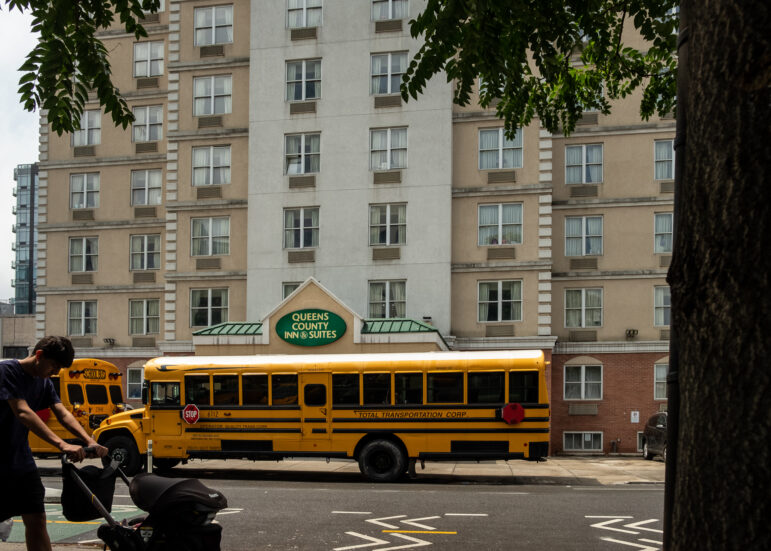“This field is underpaid, understaffed, and entering and progressing within it is only available to those who have the means for conventional schooling, and not those with the lived experience which might serve them better.”

Michael Appleton/Mayoral Photography Office
Pamphlets for some of the city’s mental health programs.Across New York City and the country at large, our mental health systems are in crisis. But not only in the ways you might think.
More people than ever are experiencing anxiety and depression, especially since the start of the COVID-19 pandemic. Youth and young adults are reporting symptoms of major depression and serious psychological distress at even higher rates. We can see the impact in our homes and on our streets every day, affecting our sense of safety, well-being, and community.
Despite this, our mental health services are failing to meet the need. This is, in many ways, due to the prolific underfunding of our mental health providers, especially those who have the lived experience to truly connect with and serve their communities.
Across the country, 49 percent of people live in areas with a shortage of mental healthcare providers. Somewhat predictably, this divide can fall along socioeconomic lines: in New York City, the Mayor’s Office for Economic Opportunity found that mental health resources were inequitably distributed in higher income areas across, and that they were also in short supply in the public sector—meaning those historically excluded from resources through systemic racism continue to lack access to those services.
This more significantly impacts Black, Indigenous, and People of Color (BIPOC), who already face worse outcomes at every step of the healthcare system. While white and BIPOC folks face similar rates of mental health challenges, the latter’s symptoms tend to last longer and are more likely to go untreated. Black mental health patients presenting with the same symptoms as white mental health patients are more likely to be diagnosed with a severe mental health condition (e.g., schizophrenia), which have higher stigmas and longer-term treatment impacts. They are also more likely to disconnect from services sooner.
One cause for this growing list of adverse outcomes stands out: in the behavioral health fields, BIPOC staff are significantly underrepresented. Though around 60 percent of the U.S. population identifies as non-Hispanic white, 81 percent of practicing psychologists identify as white. And whereas 14 percent and 19 percent of the population identify as Black or Latine, respectively, only 5 percent and 8 percent of psychologists identify as such. Similar disparities exist in psychiatry.
Having a therapist who fluently speaks your language or a social worker who grew up in the same neighborhood as you creates an opportunity to restore some of the eroded trust in a system that has historically provided only exclusion and discrimination. Practitioners from diverse backgrounds also bring unique perspectives: an understanding of the stigma against care their client may have, or ideas for what might work for a patient who has not responded well to practices developed without people who look like them in mind.
With the converging crises of heightened need for services and lack of a diverse workforce, last year, the CUNY Institute for State & Local Governance set out to understand why BIPOC were underrepresented in these fields. We spoke with over 130 “helping professionals” at all ranks—meaning social workers, psychiatrists, psychologists, credible messengers, community health workers, and more—to find out why these gaps exist and offer solutions.
The systemic racism that impedes people from accessing care, in turns out, also impacts those who want to provide it. We found that BIPOC faced barriers to entering or progressing in the mental health professions at every level of their schooling or career trajectory. This starts in elementary school and continues on into graduate school, where students from economically marginalized neighborhoods have fewer resources to explore career pathways or pay for costly tests and required certifications.
Once in the workforce, burnout and tokenism often impede career growth. A Spanish-speaking social worker we spoke to, for instance, described that bilingual staff had higher caseloads because of the high demand for services in that language, yet were unpaid for the additional labor. This led to burnout. “Because we know the language, more is asked of us,” they said. “So we are less able to give to ourselves.”
A Black woman working as one of two psychologists of color in a hospital reported feeling alone and vulnerable in the workplace, especially when experiencing microaggressions. “Do I want to be the one to speak up? I already feel isolated,” she told us. “Why does it have to be me?”
Even if they stay, a pervasive lack of proper funding in many nonprofits and other organizations that provide these services means that adequate pay and advancement opportunities are few. And when they are available, those seen as more “qualified” come out on top, though “qualified” often means more technical education—another expense—and not the lived experience that allows helping professionals to more easily connect with their clients.
To fix this, we need to rethink how we structure, support, and fund the pipeline into and through our mental health professions. From our conversations, we offer recommendations for educators, organization leaders, policymakers, and funders to do so—but one need was louder than all the rest.
We—nonprofit executives, mental health leaders, policymakers, educators—need to make this field more accessible and sustainable for all people, but especially people of color. As it stands, this field is underpaid, understaffed, and entering and progressing within it is only available to those who have the means for conventional schooling, and not those with the lived experience which might serve them better. This is not only a disservice to the mental health workforce we rely on, but the communities they care for.
This means supporting young folks—in every neighborhood, in every grade—in exploring careers in the mental health fields. This means investing in financial support for multilingual or minority college and graduate students, helping marginalized groups over systemic monetary barriers. Creating incentives for mentorship for students and early-career staff, as well, means helping to navigate schooling, internships, and job placement, particularly for first-generation students, but beneficial to all. You can’t learn how to survive and thrive from a textbook.
Nonprofit and mental health leaders, as well as funders, must promote holistic hiring, advancement opportunities, and better working conditions at social service providers. Encouraging flexible career pathways offers growth and advancement for a variety of backgrounds, rather than linear pathways, so that people who may have the practical experience but fewer technical qualifications can grow into these roles. Abolishing salary caps in requests-for-proposals would go a long way in making salaries more livable, and open opportunities for those who may not have other means of support at home.
It’s clear that treating the mental health crises in our communities is a tough pill to swallow. But we cannot ignore or incarcerate away these problems—and we need to listen to the voices in the communities that should and want to be part of the solution.
The importance of trust and understanding in mental health care—both between providers and their clients, and providers and the educators, employers, and funders who support them—is key to treating the sickness pervading our systems. As one Latine social worker put it, “I want to be the help I never received.”
Dr. Linda Lausell Bryant is an associate dean at NYU Silver School of Social Work and a youth services leader. Eric Brettschneider is a senior fellow at the CUNY Institute for State & Local Governance, adjunct faculty member at NYU and the former first deputy commissioner at the city’s Administration for Children’s Services.







